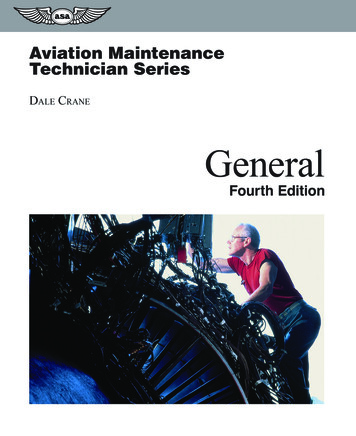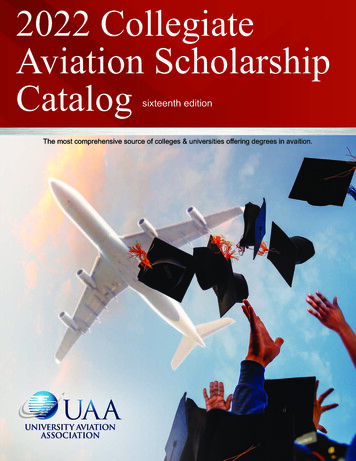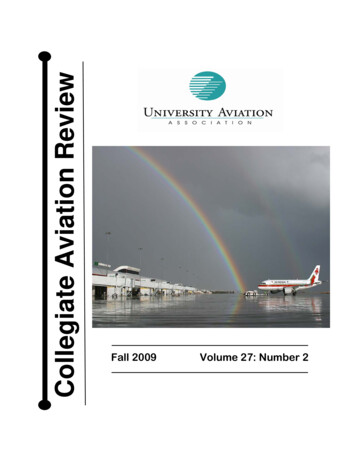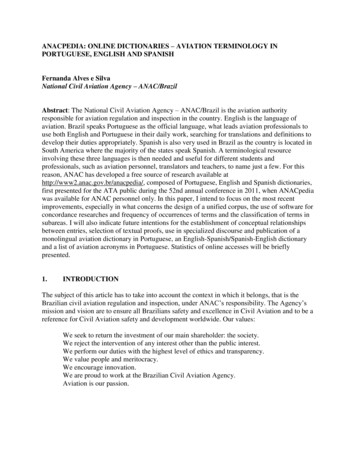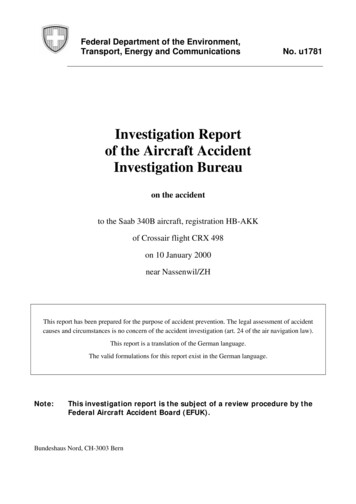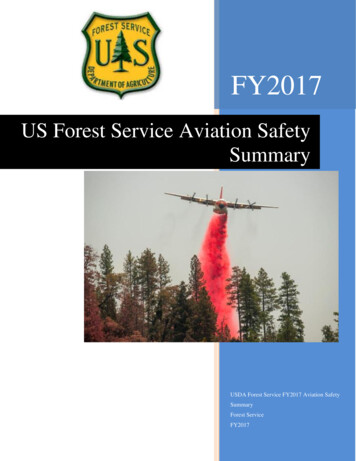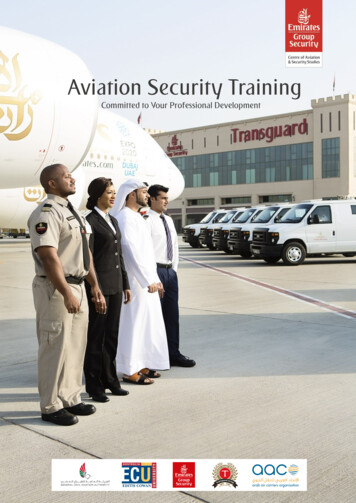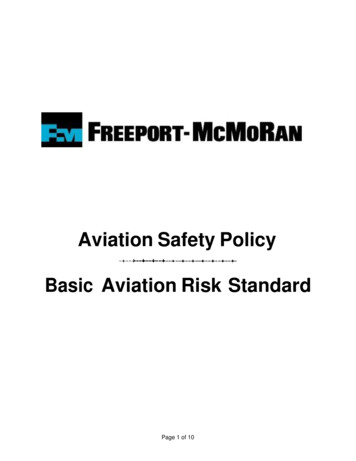
Transcription
Aviation Safety PolicyBasic Aviation Risk StandardPage 1 of 10
PreambleThis Policy will establish comprehensive minimum standards to provide a consistent approach for allFreeport-McMoRan (FCX) Aviation Safety activities to source, select and use only qualified air carriersto support FCX mining activities globally to reduce the potential risk of injuries and incidents throughthe safe transport and movement of personnel by air. These documents apply to all FCX Operations,Projects and Exploration activities.We have an obligation to our Board of Directors and our Shareholders to ensure we have the maximumsafety plan in place to protect our Board and Employees.The FCX Global Aviation Safety Manager, will have administrative responsibilities to the policy and willcoordinate the activities of the Aviation Advisors relative to this policy. The FCX Global Aviation SafetyManager will also represent FCX at Flight Safety International and will serve on the Technical AdvisoryCommittee. In conjunction with this policy, the Department of Occupational Safety and Health willmaintain corporate oversight of the policy of all aviation activities.FCX is a member of the Flight Safety Foundation and the Flight Safety Foundation’s Basic Aviation RiskStandard (BARS). This policy incorporates by reference the BARS which is a risk-based standarddesigned to be used a primary reference for FCX personnel involved in the sourcing, selection, and useof only qualified carriers.Page 2 of 10
FCX Aviation Policy1.0PurposeTo establish a comprehensive company-wide standard for chartering and hiring fixed wing and rotor wingaircraft for use in support of FCX global operations and activities. This Standard pertains to requirementsfor sourcing and selecting qualified air carriers, particularly in remote geographic locations, for thepurpose of ensuring safe, efficient and reliable air transportation services and to promote overall airtransportation safety. This standard is designed to provide optimum protection to FCX’s employees,dependents, contractor personnel and general aviation cargo.2.0PolicyThis Policy sets forth requirements for FCX Exploration Managers, Operations Managers andstakeholders, in cooperation with the Corporate Global Supply Chain (CGSC) Management Department,to source, select and use only qualified air carriers to support FCX’s global activities.Aviation transportation carriers are to be selected from the list of carriers that have been approved andcertified in accordance with the Flight Safety Foundation (FSF) BARS The responsible managers arerequired to exercise sound judgment and apply Best Practices with an over-riding concern for passengerand operational safety.This Standard does not apply to commercial airlines that are IATA certified.The following Best Practices shall be applied with the understanding that time constraints, criticalscheduling requirements and limited time to plan are not valid reasons to waive any of the followingpractices:3.1Requirements for Use of Non-Owned AircraftFCX business needs may require the use of various types of non-owned aircraft. Thesestandards provide the minimum requirements which are to be followed when using non-ownedaircraft. Exceptions to these standards will be made only by the FCX Department of OccupationalHealth and Safety (DOHS) Vice President, or delegate. Under some circumstances whenfollowing these requirements may be impossible, we should enforce the following:1. Company employees may not pilot privately owned borrowed, rented or leased aircraft forCompany business.2. Company employees may not rent, lease or charter any aircraft with more than 40 total seats(including passenger and crew) for Company business without the approval of the DOHS.3. Company employees involved in renting, leasing or chartering any aircraft must obtain a dulyexecuted written agreement from CGSC Management prior to the flight. Said agreementmust be reviewed and approved by Chief Counsel and/or legal staff prior to flight.3.2Corporate Air Travel PolicyEffective administration of the Company’s business affairs and the management of its widely separatedoperations may require the use of air transportation.Good judgment shall be used in making air travel arrangements with appropriate allowance for individualcircumstances while considering the degree of risk involved. Air travel should be made on globallyrecognized airlines. Where possible, no more than two consecutive reporting levels shall be on board thesame aircraft. All levels of management must use discretion as to the number of key personnel from any oneorganizational area of the Company allowed to fly on the same aircraft. This applies to all air travel whetheron commercial or charter flights or in group exploration charters and other business unit charters.Page 3 of 10
Whenever possible, to avoid undue risk to the Company’s ongoing operations, consideration should be givento flight arrangements so the following senior executives do not travel together on the same aircraft:1. Chairman, President and CEO;2. All Board Members;3. More than three Senior Vice-Presidents or more than two Senior Vice-Presidents with theChairman, President or CEO.3.3Aviation Transportation PlanningThe responsible FCX Manager, in cooperation with other stakeholders and the CGSC ManagementDepartment shall develop an Air Transportation Plan for its respective project, mine operation, explorationprogram or region that identifies specific long term air transport requirements. Proper planning of anyproposed activities involving aircraft shall be undertaken to ensure that the applicable requirements of thisPolicy are included. This Policy shall be applied in a manner that ensures aviation companies and aircraftoperations for Company business are provided by approved scheduled commercial air services and/orpre-approved air charter companies based on being appropriately certified in accordance with the FSFBARS.Where more than one certified air charter company is available for use, safety and reliability shall beprimary considerations for the final selection of the air charter company.3.4 Airline CertificationRegional (non IATA certified) commercial airline companies, and scheduled commercial air servicesshould provide to CGSC appropriate airline certifications that demonstrate acceptable operations andsafety performance.Many countries do not have governing bodies that appropriately administer and regulate aircraft and airtransport safety. In these circumstances, an established system of audits and inspections by a FCXassigned Aviation Auditor must take place to ensure safety and operational compliances. Refer to clause3.5 below for the appropriate methods for planning audits.3.5 Airline and Aircraft Audit RequirementIn the event certifications cannot be provided by the regional airline or commercial air service or thecertifications provided by the airline company cannot be reasonably determined as being acceptable bythe FCX Aviation Specialist, an airline company audit shall be required in accordance with the FSFBARS. FCX’s CGSC representative and the local Company manager requiring the air services are jointlyresponsible for ensuring an airline company audit by a FSF BARS certified Aviation Auditor takes placeprior to placing FCX employees, dependents or contractors on board an airline company’s aircraft.3.6Method for Planning and Conducting AuditsFCX’s CGSC Management Department will maintain a directory of BARS certified operators provided tothem by the FCX Global Aviation Safety Manager. Prior to arranging charter travel, the responsiblemanager requesting air services should consult with FCX Aviation Specialist for recommendation todetermine if said operator is BARS certified or initiate the request to conduct an audit to become BARScertified.Page 4 of 10
3.7Charter Services/Aircraft SelectionThe following order of preference shall be used when selecting aircraft (fixed wing and helicopters) forcharter flight transportation of passengers: Pressurized, multi engine, turbine powered. Single engine, turbine powered. Multi-engine, piston powered (except helicopters): and single engine, pistonpowered (except helicopters). Helicopters used for passenger transport shall be turbine powered.Single engine aircraft shall only be used for passenger transport when: Flights are conducted under daytime Visual Flight Rules (VFR); Flights are conducted with scheduled position reports, and comprehensive flight plansare logged with and maintained by an approved ground facility; Search and rescue (SAR) capability is established in the area of operations; Emergency response procedures are in place; and Comprehensive risk assessment has been undertaken.Twin engine helicopters shall be used for flights over water when the operations are conducted at aradius of more than 25 nautical miles from the nearest suitable landing area.Piston engine helicopters may only be considered after a formal assessment by FCX Risk Managementtogether with a FCX approved Aviation Auditor, and then approved by CGSC department.An approved list of charter aircraft must be established through the FSF BARS and such list will bemaintained by the FCX Global Aviation Safety Manager. The charter company will not be permitted to flyvendor/outside aircraft without prior written approval of the FCX Global Aviation Safety Manager. Anyvendor/outside aircraft must fly under the same guidelines as the charter company.3.8Charter Aircraft ServicesAviation charter companies hired by FCX under a charter agreement shall be hired with either a termcharter contract or a miscellaneous charter services contract. Charter agreements shall be awarded toaviation charter companies that have been audited by the FSF BARS and meet minimum requirementsas approved by FCX management.Page 5 of 10
3.9Insurance RequirementsThe Company employee hiring the aircraft shall obtain a certificate of insurance from the Operator oraircraft owner prior to departure with the minimum required insurance limits and coverage set forth below,naming FCX and the applicable Company as additional insured’s (see exact wording in paragraphs 1, 2and 3 below).Certificates of insurance must show an Operator's full policy limits and shall include War Risk liabilitycoverage in addition to the minimum liability limits provided in the table below. The following are minimumliability limits based on the type of aircraft:Type of AircraftSingle Engine Piston FixedWingMulti-Engine Piston FixedWingSingle Engine TurbopropMulti-Engine Turboprop/jetHelicopters (6 seats or less)Helicopters (7 - 12 Seats)Helicopters(13 seats &greater)Minimum Liability LimitsPrior approval required from FCX Risk Management 3,000,000 per passenger* 3,000,000 per passenger* 5,000,000 per passenger* 10,000,000 Combined Single Limit, Including Passengers 15,000,000 Combined Single Limit, Including Passengers 30,000,000 Combined Single Limit, Including Passengers*If the maximum number of passengers to be flown is not accurately known, multiply the perpassenger limit shown above by the total number of passengers seats of the aircraft.1. Aircraft Liability Insurance. Aircraft Liability insurance (including War Risk), including bodily injury(including passengers) and property damage liability with a limit of not less than the appropriateUS limit per the chart above including aircraft passengers for each occurrence/aggregate. Suchaircraft liability policy shall name Charterer and, if different, FCX Copper & Gold, Inc. and theirrespective parent, subsidiary and affiliated companies and the directors, officers, employees,contractors and subcontractors of each, as additional insured’s, as their respective interests mayappear, and shall include cross liability and a clause stating that such insurance is primary withrespect to the aircraft, or substitute, or replacement aircraft used in performing the Agreementand such insurance shall not be contributory with or excess over any insurance carried byCharterer and, if different, FCX Copper & Gold, Inc. and their respective parent, subsidiary andaffiliated companies and the directors, officers, employees, and contractor/subcontractor of each.Such insurance coverage shall include War Risk liability coverage.2. Aircraft Hull Insurance. Aircraft hull insurance covering the aircraft hull and engines and all aircraftequipment against "All Risks" of loss or damage for the full replacement value of the aircraft.Such insurance shall contain, by endorsement, a waiver of subrogation in favor of Charterer and,if different, FCX and their respective parent, subsidiary and affiliated companies and the directors,officers, employees, and contractor/subcontractor of each. All deductibles under such insuranceshall be for the account of Operator.3. Worker's Compensation and Employer's Liability Insurance or Equivalent. Worker'sCompensation and Employer's Liability Insurance (or equivalent insurance) covering statutorybenefits for all of Operator's employees with a minimum employer's liability limit of 1,000,000 peroccurrence. To the extent permitted by any applicable law, such insurance shall contain, byendorsement, a waiver of subrogation in favor of Charterer and, if different, FCX and theirrespective subsidiary and affiliated companies and the directors, officers, employees, contractorsand subcontractors of each.Page 6 of 10
3. 10Certificate of Insurance. Prior to commencement of the Agreement, Operator shall provideCharterer with a Certificate of Insurance complying with the provisions contained in paragraphs 1,2 and 3 of clause 3.9 above. Such certificate of insurance shall also provide that insurers agree toprovide 30 days written notice to Charterer prior to a cancellation, or material restrictive change,of the policy with respect to the aircraft for which the certificate is issued which would adverselyaffect the interest of such additional insureds.Dangerous Goods and FirearmsDangerous goods include gases (compressed, liquefied, refrigerated), flammable solids (e.g. liable tospontaneous combustion or reactive on contact with water), oxidizing materials, poisonous or infectioussubstances, corrosives and a range of other hazardous materials (e.g. mercury). The aircraft operator canadvise on the acceptability of the goods and specific packaging instructions. If any doubt exists as to thenature of the goods proposed to be transported by air, or to the correct packaging or handlingprocedures, the goods shall not be transported by air.3.11Non-FCX Limited Charter FlightsExcept in emergencies, FCX personnel and their dependents shall not fly on non-Company charteredflights unless: The charter service conforms to the requirements of this Standard; and Appropriate agreements have been arranged in advance with the provider of thecharter flights,Approval shall be obtained from CGSC department in such cases.4.0.FCX Aviation SpecialistAn FCX Aviation Coordinator will be named for each Regional Area of the FCX organization. They willreceive BARS training certification, and assume specific responsibilities related to Aviation Managementpractices. For purposes of this policy they will report administratively to the FCX Global Aviation SafetyManager.A current roster of the Regional FCX Aviation Coordinators will be kept current by the FCX GlobalAviation Safety Manager and will be distributed as changes to the roster are made.Debby ChauppettaGlobal Aviation Safety ManagerCynthia DavisDirector, GSC North American OperationsJohn MelfiExploration Safety ManagerChris RoseDepartment of Occupational Safety and HealthJohn FultonSafety Manger (Tenke Fungurume Mining)Chris ChristensonField Operations and SHE Director (MineServe International)Paul BassSenior Aircraft Mechanic (Tenke Fungurume Mining)David JonesGeneral Supt. of Technical Department Aviation (PTFI – Airfast)SolihinSafety Manager, PTFIPage 7 of 10
Aircraft Charter, Airplane and HelicopterBasic Aviation Risk StandardIntroductionThe following requirements should where applicable be read in conjunction with the following GeneralCharter Standards for the specialist activity being undertaken which may contain more restrictiverequirements:All Threats 1.0:Threat 2.0:Threat 3.0:Threat 4.0:Threat 5.0:Threat 6.0:Threat 7.0:Threat 8.0:Threat 9.0:Threat 10.0:Defences 11.0:Appendix 1:Appendix 2:Appendix 3:Appendix 4:Appendix 5:Common ControlsRunway ExcursionsFuel ExhaustionFuel ContaminationControlled Flight Into Terrain (CFIT)Incorrect LoadingCollision on GroundCollision in AirStructural or Mechanical FailureWeatherAircraft AccidentAircrew Qualifications and ExperienceBasic Aircraft Equipment FitAbbreviationsExternal Load OperationsOffshore OperationsUnless otherwise stated, these requirements will be applied to both short and long term aircraft charterand form the basis for ongoing aircraft charter support.The unique nature of many FCX activities requiring long term aircraft charter contracts may result invariations to these requirements. Any such variations shall be reflected in contract documentation, afterapproval from the responsible FCX Manager, and in coordination with CGSC management.Local Regulatory requirements take precedence over FCX’s requirements where they are more stringent.Purpose of Basic Aviation Risk Standard1This document is to provide FCX with a standard to assist in the risk-based management of aviationoperations supporting operational activities.All national and international regulations pertaining to aviation operations must always be followed. Thedetail contained in this standard is intended to supplement those requirements.StandardThe standard herein adapted by FCX is presented in a risk-based format to emphasize the relationshipbetween threats to aviation operations, associated controls and applicable recovery/mitigation measuresas presented in Figure 1.1The materials herein have been adapted from the "Flight Safety Foundation" Basic Aviation RiskStandard – Resource Section, Version 3.Page 8 of 10
The risk-based presentation is further intended to assist all FCX personnel engaged in coordinatingaviation activities to manage and understand the aviation risk to their operation.As a basic standard, all FCX staff and aircraft operators are encouraged to further risk-assess all controlsto the level of detail they consider necessary for their individual operations.Aircraft Operator ReviewThis standard is designed to be used as a primary reference for the review and approval of aircraftoperators supporting FCX operations.Emergency Response ProcedureEach jobsite, operation or asset using aviation services should make provisions for aviation emergenciesin their Emergency Response Plans (ERP), and communicate these plans to all relevant personnel. TheERP should be developed in co-operation with the aircraft operator providing services to ensure that inthe event of an aviation emergency, any adverse outcome is minimized.Search & Rescue capabilities by aircraft are significantly limited at night, and should be taken intoaccount if late afternoon or night flights are undertaken.Scenario based emergency drills with specific objectives should be conducted within 30 days of a newproject start and annually for ongoing operations. The drill should involve the aviation resource andinclude pilots, support staff, aircraft, and be integrated with marine or land surface resources asappropriate.Exercises involving aviation aspects of the ERP should test field communication capabilities whereapplicable, as well as aviation coordination with ground and resources.The types of exercises that can be planned (but not be limited to) include the following:a) Fire – involving an aircraft, and/or helipad.b) Missing, or overdue aircraft.c) An aircraft forced landing.d) Search & Rescue operation, use of emergency equipmente) Helicopter winching exercises.f) Oil and Fuel spillg) Medical evacuation, including stretcher drills.Planning & conducting emergency response drillsThe planning for the safe conduct of drills should be documented and discussed with the aviationparticipants prior to the conduct of any exercise. Any safety restraints as a result of night operations orrestrictions due to weather should be documented in this plan. Active participation from the AircraftOperator is expected in the determination of the weather minimums for the conduct of the drills. Areasthat should be taken into account include visibility, wind speed, temperature limits and sea states. Tovalidate the integrity of the specific scenario drill, the exercises should be varied with regard to the time ofday, and the day of the week. At the conclusion of each exercise, the drill should be critically assessedand all personnel fully debriefed. All subsequent recommendations should be documented for follow-upaction.Search & Rescue (SAR) services & equipmentOperators carrying company personnel should be equipped as necessary with SAR supportive equipmentand be backed by an appropriate level of rescue service that can be directed to the operating areawithout delay. In some instances civil or military authorities must also be notified and cooperationmaintained to facilitate SAR activity. The FCX Aviation Specialist can assist with determination of whichequipment and services may be necessary. Factors to be considered include the following:a) Environment of hostile versus non-hostile.b) Anticipated survival time of occupants versus anticipated rescue time.Page 9 of 10
c) Local agency support.d) SAR Support Equipment.Survival equipmentAll aircraft should carry safety equipment and survival kits that, as a minimum, comply with local civilaviation authority or regulation. When considered necessary, the Company may request additionalequipment subject to the operating environment. The items contained in survival kits should beappropriate for the geographical location and climatic conditions; for example, offshore, arctic, jungle ordesert. The capacity of each survival kit should be proportionate to the number of persons carried in theaircraft and sufficient to sustain all persons on board for a minimum of two (2) days at normalconsumption rates.Overdue aircraftAn aircraft which fails to contact flight following at required time intervals, or fails to respond to radiocontact, is considered overdue. If any aircraft is reported overdue through the Flight Following facility, orother means, actions detailed in the Emergency Response Plan should be initiated. A check list sheetshould be used from the first instance to ensure all appropriate actions are undertaken and to documentall relevant information.Emergency Preparedness PlanNotwithstanding the air operator’s regulatory, local and/or national legislative Mandatory OccurrenceReporting obligations, all contracted air operators will advise the FCX manager chartering the aircraft andthe onsite Health and Safety manager of any incident, accident or occurrence that has, or potentially has,disrupted operations or jeopardized safety. Notification will be made verbally immediately and in writingas soon as practicable. The written report will include any follow up or corrective action as appropriate.(In the interests of sharing safety related material any non-FCX incidents involving the aircraft operatorshould also be notified.) The definitions of an Accident, Incident & Serious Incident are contained inInternational Civil Aviation Organization (ICAO) Standards & Recommended Practices, Aircraft Accidentand Incident Investigation – Annex 13 to the Convention on International Civil Aviation. In any event, theadherence to a detailed Emergency Response Plan will assist in providing clear and coordinatedprocedures to deal with all possible scenarios.Once a FCX Manager has been advised of a serious incident or disaster involving FCX chartered aircraft,they will immediately make the following notifications: Ensure that local Emergency Medical Services and Fire Department have been notifiedContact local regulatory and/or Law Enforcement authorities as appropriate.Notify FCX Department of Occupational Health and Safety who will notify FCX Communications,and FCX Senior ManagementConsult FCX Chief Counsel and Legal team for guidanceNotification to ISOS for additional emergency medical services support if neededNotification to Control Risk Group (CRG) for additional security supportThe Manager will also begin to document the sequence of events, collect written statements and relevantrecords in a timely manner.Page 10 of 10
3.8 Charter Aircraft Services Aviation charter companies hired by FCX under a charter agreement shall be hired with either a term charter contract or a miscellaneous charter services contract. Charter agreements shall be awarded to aviation charter companies that have been audited by the FSF BARS and meet minimum requirements
